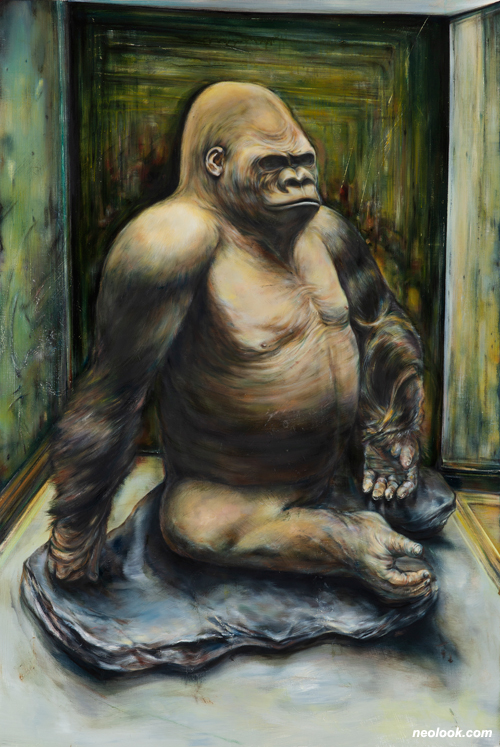- ● homepage
- ● archives
- ● restoration
- ● books
- ● big banners
- ● post board
- ■ neo's search
- ■ about us
- ■ 게재방법 안내
- 개인정보처리방침

- [email protected]
- Tel. 02_335_7922
- Fax. 02_335_7929
- 10:00am~04:30pm
- 월요일~금요일
- 3/3(월) 대체공휴일

동물혼 Animal Spirits 動物魂
박미례展 / PARKMIRAE / 朴美禮 / painting 2021_0430 ▶ 2021_0513
● 위 이미지를 클릭하면 네오룩 아카이브 Vol.20190127a | 박미례展으로 갑니다.
별도의 초대일시가 없습니다.
후원 / 서울문화재단_서울시
관람시간 / 11:30am~06:30pm
인디프레스_서울 INDIPRESS 서울 종로구 효자로 31(통의동 7-25번지) Tel. 070.7686.1125 www.facebook.com/INDIPRESS
큰 양의 예의 - 박미례 개인전 『동물혼』 리뷰 ● (박)미례의 기존 작업과 이번 전시의 연속성은 우선 그녀가 베를린 자연사 박물관에서 보았던 박제된 고릴라 '바비'가 다른 모습으로 등장한다는 데서 찾을 수 있을 것 같다. 미례는 발굽이 둘로 갈라진 포유류, 소, 양, 사슴, 염소를 통칭하는 우제류(偶蹄類)의 박제된 모습, 간혹 나비나 곤충의 표본도 목탄 드로잉이나 회화로 재현해왔다. '박제'는 미례가 동물의 사실주의적 재현의 소재로 사용하는 인간 문명 안 동물의 존재방식이다. 나고 죽는 생명은 모두 생전의 가시적 형태를 벗고 자연의 최하위 형태로 해체되고·회귀하지만, 인류의 획기적인 기술은 죽음 이후에도 부서지지 않는 외피, 껍데기로서 생명의 시뮬라크르적 영생을 가능케 만들었다. '거리'의 장치-기술을 통해 바깥에 위치한 채 세계를 즐기는 인간의 관음증적 욕망이 근거리로 클로즈업한 타자의 기괴한 바깥을 전시가능한 것으로 만든 것이다. 자연사 박물관에서 "고독한 마네킹들의 전당포 같은 느낌"을 받았던 미례는 2살에 동물원에 갇혀 9살에 죽고 삼면이 유리로 된 구조물에 다시 갇힌 채 영원히 바비로서 보여지는 고릴라의 서사에서 다름아닌 인간의 전형을 본 것인지 모른다. 생사를 관장하는 신의 자리를 넘보는 인간의 욕망에 의해 다시-살아난 고릴라는 욕망의 광기, 욕망의 집요함의 가시적 이미지일 것이다. 미례는 회화적 수정을 거쳐 그런 고릴라에게 부드럽게 칠해진 저채도의 칼라를 입혔다. 시간성을 장악한 돌 위에 올려진 반-자연적인 고릴라의 '실존'은 일견 돌과 유사하지만, 미례의 눈에는 자연을 교정하고 즐기는 인간의 획책만이 보이지만, 그렇다면 마네킹처럼 보이는 박물관의 사물에 대한 미례의 회화적 교정은 부식과 변화를 넘어서려는 회화의 오랜 욕망과 더불어 한참 생각해보아야 할 특이한 방식일지 모른다.
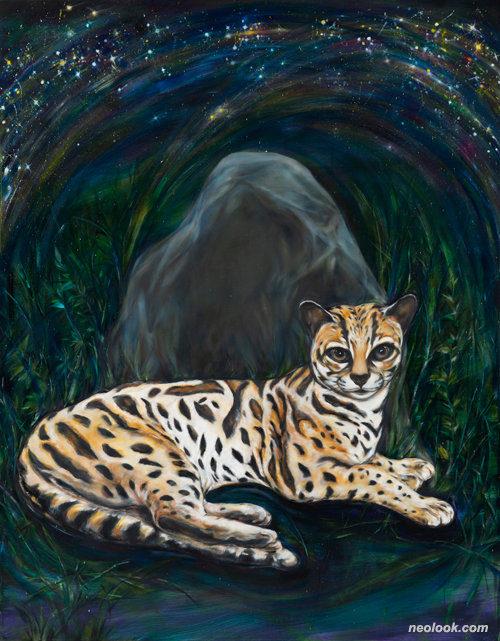
- 박미례_삵 Nocturnal Guardian of the Tombstone_캔버스에 유채_185×145cm_2021
유한성, 죽음, 시뮬라크르, 붓질, 회화, 눈 없는 눈만이 볼 수 있다는 것을 보고 있는 '바비', 그리고 박제된 고릴라를 그리고 그것의 이름을 부르는 미례. ● 세 마리의 젖소가 등장하는 「젖소」는 계속 우유를 생산할 수 있도록 영구적으로 임신 상태로서만 살아가게 강제된 젖소에 대해 친구가 들려준 이야기를 소재로 한다. 젖소는 바비와 달리 분명 살아있지만, 인간의 기술에 의해 조작된, 박제된 시뮬라크르일지 모른다. 미례의 전시에 간간이 등장하는 접시꽃은 "여름이 시작될 때 피는 잡초랑 비슷한 꽃"이란 주관적인 해석과 함께 사실주의적으로 재현된다. 꽃으로 불리기엔 접시꽃은 너무 흔하고 너무 후하고 너무 시시하다. 미례는 접시꽃에서 한철 피고 지는 생명의 무상을 본다. 거진 꽃의 의미-가치를 탈각한 접시꽃의 재현적 이미지는 흡사 '광(狂)'에 대한 시각적, 기호적 번역 같다. 꽃과 잡초의 중간에서 발광하는 너무 붉고 초록인 생(生). 미례가 인용하는 소재들, 이미지들은 모두 미례의 주관적인 해석이나 느낌에 근거하여 인용되지만, 그렇다고 그런 주관적인 해석을 통해 조형적으로 변형, 변용되지는 않는다. 미례는 자연 상태의 생명체들을 이미지로서, 알아볼만한 형태로서 보존한다. 박제기술자가 그렇듯이. 제목은 직접적으로 그려진 대상을 가리키고, 심리적이거나 주관적인 해석은 밑그림처럼 눈에 안 보이고, 그러므로 대상들은 고립되어 있다. 인간을 중심으로 돌아가는 세계에 대해 미례는 비판도 의미도 가치도 수여하지 않는다. 그것은 그녀에게 이 세계가 알 수 없는 것이기 때문이다. 그녀가 어떤 인간적 관점을 차지하고 그것들을 유유히 바라보려고 하지 않기 때문이다.
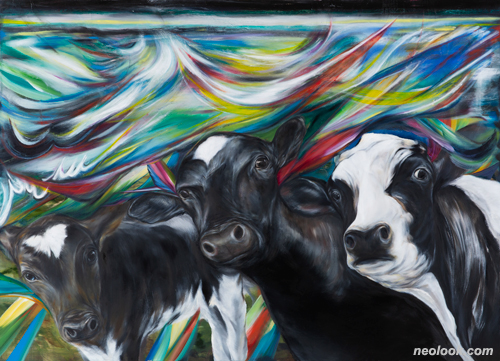
- 박미례_젖소 Cows_캔버스에 유채_130×194cm_2020
"끝까지 알 수 없는 세상에 살고 있다"고 생각하는 미례의 '퍼스펙티브' 안에서 생명체의 현재는 그것의 기이한 실존으로서만 표지된다. 너머의 자연(自然)이건 이곳의 문화이건, 그것(ça)이건 그것을 통제하고 즐기는 주인-인간이건 모든 생명체는 욕망으로서 '광기'와 연접(連接)해 있다. 미례는 그것을 분류하지도 즐기지도 않으면서 그 안에 함께 있으려 한다. 그것은 섣부른 분노나 연민, 혐오의 감정으로 해소되어서는 안 되는 조건, 운명, 상태일 뿐이다. 초월적인 시선으로 즐기고 관조하는 이들의 태도를 갖지 '않은' 채 미례는 생과 사를 조건짓는 모든 스펙트럼을 받아들이고 수용하려고 한다. 알 수 없는 이 세계에 미례도 알 수 없는 생명으로서 함께 속해 있음을 망각하지 않으려고 한다. "오만가지 잡생각과 순식간의 것들"을 빨아들이고 흡수하는 이 무지와 겸손의 자리에서 미례는 대신에 즉흥적이고 우연적인 상태를 수용하는 회화나 드로잉을 한다.
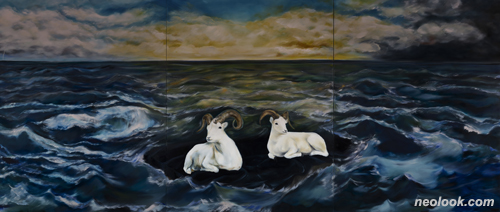
- 박미례_오직 두 마리 Only Two_캔버스에 유채_185×435cm(185×145cm×3)_2021
미례는 "땡길 때" 그린다고 한다. 자신이 시작하는 것이 아니라 그것이 시작할 때 거기에 가담하는 것이다. 미례의 작업으로 들어온 대상들, 이름들, 생명체들은 모두 나름의 이야기를 통해 선정된 것이지만 그것들을 총괄하는 '주제'는 그렇기에 거진 그녀의 것이 아니다. 그녀의 개인전 제목은 가령 외할아버지가 생전에 들려준 문장이거나 비평가가 쓴 전시 서문의 제목이거나 이번 전시 제목 『동물혼』처럼 그녀가 읽은 책의 제목이다. 2019년의 개인전 제목 『무작위의 기술Random Drawings』은 어쩌면 자신의 작업 방식에 대한 글자 그대로의 묘사인 듯 보인다. 레지던시 공간을 집과 작업실로 전전하고, 연고 없는 변두리를 거처 삼아 옮겨다니는 미례의 감각은 그녀가 재현하는 취약하고 불안정한 생명체들의 존재방식과 그닥 다르지 않다. 지금 있는 곳에서 보고 읽고 듣는 것들에 감각적으로 충실 하려는 회화에서 그러므로 유기적이고 연속적인 '전체'를 찾기는 쉬운 일이 아니다. 뜨내기의 불안한 정서는 변화와 시간에 충실할 수밖에 없는 것이며, 그런 불확실함의 정서와 실존적 조건은 그녀가 재현하는 존재들의 상태에 다름 아닌 것이다. 감각으로서, 바깥에 열린 상태로서, 죽음과 연접한 생존으로서 현재를 통과한다는 것, 그것은 알 수 없는 삶을 알 수 있는 것으로 만들 수 없는 무능과 그러므로 유능을 겸비하게 되는 것에 다름 아니다.
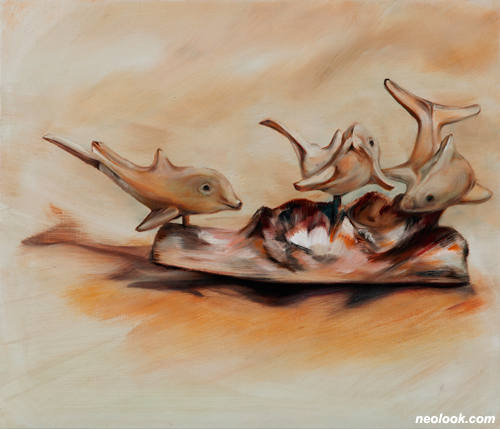
- 박미례_목각돌고래 Wood carved Dolphins_캔버스에 유채_45.5×53cm_2020
미례는 자신의 소재, 대상을 사실주의적으로 인용하되, 그것들에게 화가로서의 자신이 '줄' 수 있는 배경, 무대를 수여함으로써 유한한 삶의 문화적, 인위적, 자연적 스펙트럼들에 대한 자신의 회화적 '긍정'을 가시화한다. 그렇게 살아있음, 어쩔 수 없음(it is what it is!), 그런 사실에 대한 미례의 수수방관과 응시는 그것들을 '실존적' 맥락에서 뜯어내 캔버스로 옮겨와 그것들에게 그녀의 '광'적인 색채, 대담한 붓질을 입히는 행위에 의해 일시적으로 진정된다. 그녀에게는 잠시 보는 눈을 감는 휴식이자 회화적 제의이고, 그것들에게는 새로운 삶이고, 결과는 회화이다. 그래서 또 보면 바비는 투명한 유리가 아닌 칠해진 벽에 모셔져 있고, 젖소들은 "굿당"의 오방색 천에 둘러쌓여 한바탕 축제 중이고 「벌새 우주」의 벌새는 초현실적인 칼라의 리듬과 운율 속에서 춤추고 있고 「오직 두 마리」의 염소는 제자리를 모르는 바다와 하늘 위에 떠 있다. 제자리가 '미친' 자리인 존재들은 미례의 색, 붓질, 미례의 비유법을 통해 제자리에서 더 밀려난다. 이미지의 적절성을 이미지의 유희가 대체한다. 의미나 가치를 묻는 대신에 맥락을 지움으로써 회화적 이미지의 유희에 집중하는 것. 실존적 광에 회화적 광으로 응대하는 것!
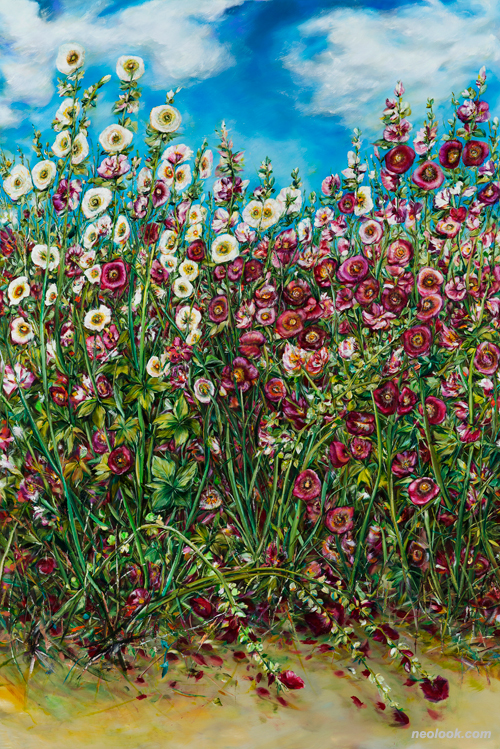
- 박미례_접시꽃 Hollyhock_캔버스에 유채_194×130cm_2021
미례의 회화는 어떤 회화인가? 회화는 지금 없는 것을 기억하려는, 죽음을 유예하려는 일종의 인간화된 영원성 아닐까? 일종의 박제술 아닐까? 이미지로 실체를 대체하려는? 변화와 시간을 거스르려는 수많은 인간의 작용 중 하나 아닐까? 초상화나 정물화, 동물화와 같은 재현적 회화는 죽음을 길들이려는, 죽음과 협상하는 오래된 방식일까? 미례는 자신의 회화를 "영정 사진"이나 "추모화"라고 부른다. 「미의 예」, 미(美)-례(禮)란 이름에 각인 되어 있는, 그녀가 어쩔 수 없이 따르고 있는 운명이다. 자세히 보면 아름다울 미는 큰 양이다. 아름다움은 우제류에서 왔다. 미례는 우선 큰 양이고, 그렇게 미의 예를 갖추고 무대를 설치하는 자이다. 부모님이 그녀에게 입혀준 이름, 바깥이 그렇게 그녀의 운명을 이끈다. 그래서 재현적 이미지의 회화적 구성물들 사이에 한자 드로잉으로 그녀의 이름이 나란히 전시된다. "끝까지 알 수 없는 세상"에서 자신도 모르게 자신을 강요하는 알 수 없는 힘에 대한 응시이고 긍정이다. ■ 양효실

- 박미례_미의 예 MiRae_종이에 목탄, 콘테_49×76cm_2021
Homage to the Big Lamb - Review of Park Mirae's solo exhibition 『Animal Spirits』 ● There is a continuity throughout (Park) Mirae's work: the taxidermized body of Bobby the gorilla appears again and again in her paintings, having first been encountered at Berlin's Natural History Museum. Mirae has depicted hoofed and even-toed mammals, so-called Artiodactyla such as cows, sheep, deer, goats, and sometimes even specimens of butterflies and insects with charcoal drawings or paintings. "Taxidermy", the realistic representation of animals as they exist in human civilization, is explored by Mirae as a central theme. All aspects of nature ultimately decay and return to the lowest form, their visibility in this world extinguished, but the disruptive technology of humankind turns fragile life into an eternal simulacra as a shell or hide that is never broken, even after death. The voyeuristic desire of human beings to enjoy the world while positioned outside of it through the device-technology of "distance" explains the bizarre practice of seizing and displaying the shells of others. Mirae, who saw the animals in the Natural History Museum as solitary mannequins of a pawnshop, might have felt the same way toward the narrative of Bobby the gorilla, who was trapped in a zoo at two and died at nine. He was then once again confined by glass walls on three sides, captured and displayed by humankind even in death, such is typical of humankind. The gorilla, re-born by the human desire to overtake God's place governing life and death, becomes a symbol representing insanity or obsession with their craving. Mirae applies a soft, low-saturated colour to the gorilla. The half-natural gorilla mounted on a stone and transcending time looks, at a glimpse, to be no different than the stone, but in the eyes of Mirae, it is seen as merely a scheme by humankind to correct and indulge in Nature. This is an important point to consider regarding Mirae's style in relation to the ongoing desire of drawings to overcome corrosion and deformation. ● Limitlessness, death, simulacrum, brush strokes, paintings, Bobby who can see the world in a way only eyes without eyes can see, and Mirae who draws a taxidermy gorilla and calls its name. ● The work "Cows", which has three cows side-by-side in the canvas, comes from her friend's story about cows who are permanently forced to live in a pregnant state so as to continuously produce milk. Cows are alive, unlike Bobby, but they may also be taxidermized simulacra manipulated by human technology. The hollyhock, which occasionally appears in her drawing, is realistically represented according to her subjective interpretation, "flowers similar to a weed, blooming when summer begins." The hollyhock is too common, too numerous, and too banal to be called a flower. Mirae grasps the vanity of life as illustrated in the hollyhock, which blooms and falls only for a short time. ● The image of hollyhocks, plants that so nearly evade the meaning of "flower", is a visual and symbolic translation of "madness." In the midst of flowers and weeds, they are almost too red and too green, with a sparkling luminescence. The subjects or images explored by Mirae are exploited based on her subjective interpretation or inspiration; however, that does not mean that they are transformed or deformed by her arbitrary interpretation. ● Mirae preserves life in its natural state or as recognizable forms. This is exactly what taxidermists do. Her work titles directly refer to the object itself on the canvas; therefore, her psychological or subjective interpretation is hidden like a rough sketch, isolating the objects exposed on the canvas. Mirae does not make any criticism, comment, or praise of the world dominated by humans. This world is unknown to her. She does not endeavour to take any human perspective or observe them leisurely. ● In her perspective, "we only live in an entirely unknown world": the present existence of life is marked by its peculiarity. Whether it is Nature beyond the world, or the culture of this world, or a master-like human who controls and indulges in it, all living things are connected with 'insanity' pursuing their desire. Mirae endeavours to remain in the world without classifying it or indulging in it. Remaining is a condition, a destiny or state that cannot be influenced by futile anger, compassion, or distaste. Mirae tries to accept all things on the spectrum between life and death, unlike others who hold themselves away from the world. She tries to be attentive to the notion that she belongs to this unknown world as an unknown life. In this place of ignorance and humility, which absorbs and takes in "thousands of miscellaneous thoughts and instantaneous things," Mirae instead makes paintings or drawings that acknowledge spontaneous and accidental status. ● Mirae is known to draw when she feels the impulse. She doesn't initiate the process herself but engages herself in it once it has begun. The subjects, names, and creatures that came onto Mirae's canvas were all picked for their own narrative, however, the overall "subject" that embraces them loosely belongs to her. The titles of her solo exhibition come from the sentence that her maternal grandfather once said to her when he was alive, or from the title of an exhibition preface written by a critic, or from a book title she read, as with this exhibition, 『Animal Spirits』. Her 2019 solo exhibition titled 『Random Drawings』 might have looked to be a literal portrayal of her own way of painting. Her insecure sense of moving living space between home and studio in the suburb area without any connections is not very different from the lifestyles of the vulnerable and unstable creatures that she represents in her painting. Therefore, it is not easy to find an organic and successive "entity" in her paintings that is faithfully birthed from what she sees, reads, and hears where she is present. The unstable sentiment of a wanderer is bound to transition and time flow, and such uncertainty and existential conditions are reflected in the state of the creatures she draws. ● Passing across the present through our sensations, open to the world and straddling life and death, we realise our inability to make the unknown known. But this is, in itself, a form of ability with its own strength. ● Mirae paints her subjects or objects into her paintings as they are, but by granting them a backdrop or stage that she can "present on" as a painter, it becomes possible to visualize her pictoral "positivity" against the cultural, artificial, and natural spectrum of finite life. Mirae's let-it-be attitude, her acceptance of destiny in the living world, allow her to tear her subjects apart from their existential context and transfer them onto the canvas, temporarily pacifying them with her coloring of "insanity" and daring brushstrokes. Her painting is a form of pictoral ritual that breathes new life into the objects on her canvass. Accordingly, Bobby the gorilla is enshrined not by a transparent glass prison but painted walls; cows are enjoying the festival, surrounded by Obangsaek (the color scheme of the five Korean traditional colors) of the "shaman shrine". Hummingbirds in 「Hummingbird Cosmos」 are dancing in the rhythm and rhyme of surreal colours, and two goats in 「Only Two」 are floating in the sea and the sky where they should not rightfully be. These beings in "insane" places are further dislodged out of their place by Mirae's dazzling colours, brush strokes, and metaphors. The image play replaces the reality of the subjects in the image. She focuses on the image play for paintings by deleting context instead of questing for meaning or value, counter-responding to existential insanity with pictorial insanity! ● How can Mirae's paintings be characterized? Are her paintings not portrayals of humanized eternity, of remembering what is no longer present and holding off death? Are they not taxidermy? Isn't this an attempt to replace existence with an image? Isn't it one of the numerous human acts endeavouring to counter deformation and time? Are representational paintings such as portraits, still life paintings and animal paintings not a long-term way of taming or negotiating death? Mirae calls her paintings "remembrance portraits" or "Memorial Paintings". Engraved in her name's meaning of Mi (美)-Rae (禮), 「Homage to Big Lamb」 is the destiny that she is bound to follow. Looking closely into Mi (美), it comes partly from 羊(lamb). Mi (美), meaning beauty, comes from Artiodactyla. Therefore, Mirae means big lamb first, and then Rae (禮) means a person who sets up a stage with an homage. Her name given by her parents, her outer world, leads her path in this way. This is why her name in the style of Chinese drawing is displayed among her other paintings. It is an affirmation of the unknown force that she cannot resist "in an entirely unknown world". ■ Yang Hyosil(Translated by Hyojung Kim)
Vol.20210430c | 박미례展 / PARKMIRAE / 朴美禮 / painting

